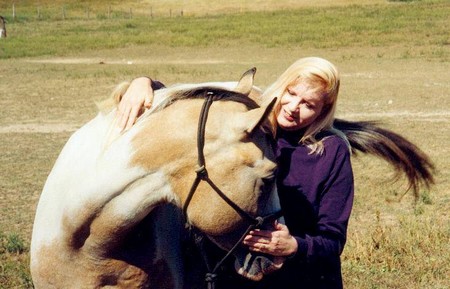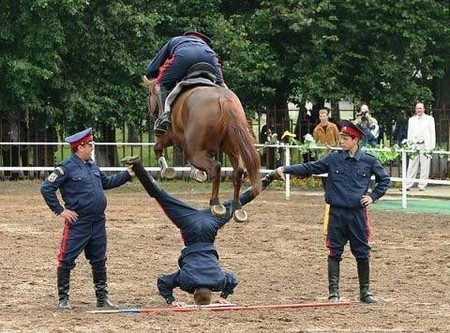At Sea World, animals are taught to do amazing things. You may have seen the spectacular performances in the shows. In addition to those examples of dramatic training, they’re taught husbandry behavior such as remaining still to allow blood samples to be drawn, traveling in transport vehicles, or volunteering urine or milk samples. One whale who required dental work learned to keep his mouth open while his teeth were drilled and cleaned.
Captive whales and dolphins work and play in a controlled environment. They are taught behaviors in that familiar, predictable atmosphere. Once the animals know their behaviors and are performing them regularly, there is little additional input required from the trainers. The trainers provide cues to communicate when and how long to perform specific behaviors. The stable environment reduces the variables.
Working with horses is different. There is an amazing amount of team work involved, along with a great many variables to deal with on a regular basis. With horses, there are constant changes in the environment. You need your horse to be responsive and compliant, especially as you begin to do more things with him. Naturally, you want to eliminate balking and spooking as much as possible, since these behaviors could result in injury. That’s why it’s important to develop focus as well as trust between horse and rider and to foster a partnership.

When I was first learning to ride, what impressed me the most is the partnership between horse and rider. A partnership goes both ways. You need to be able to trust your horse. To develop a rider’s trust, a horse needs to consistently listen and respond. Likewise, your horse needs to trust you to be consistent and reliable. This type of relationship is not built on fear. On the contrary, a truly responsive and compliant horse is relaxed and alert, impossible to achieve in a relationship based on fear. Fright results in anxiety and tension, conditions that do not bring out the best qualities in either a human or equine partner. That’s why nervousness has no place in the partnership equation. In any environment or situation, make a strong effort to minimize your horse’s nervousness.
No matter what your training plans are for your horse, you want a horse who listens and is responsive. The most effective way to achieve this is to build up an appropriate reinforcement-history, using reward-reinforcement or removal-reinforcement. As we discussed earlier, both methods when used properly are very effective training tools. However, since removal-reinforcement tends to achieve results with the unwelcome possibility of greater frustration and less motivation from the horse, we focus on reward-reinforcement. Even complicated behaviors that involve great effort can be attained solely through reward-reinforcement.
Incorporating reward-reinforcement into your training program can change your horse’s attitude about your partnership. With this approach, horses actually begin to look forward to working with you. In the beginning of the training process, they connect these actions with getting fed. We have all witnessed the great lengths horses will go to for food. Soon, the association with food becomes linked to the whole training experience, and your presence becomes a conditioned reinforcer. Your horse will be eager to be with you since he’ll connect you with the schooling sessions during which he is fed. There have been times when someone mistakenly fed our horses their dinner when we were planning to do a training session. Even though they had food in front of them, they voluntarily left that meal to come out and work. Once, when I took our horses out for a training session, I discovered they were not hungry. They weren’t sick but probably had little appetite since they had spent eight hours traveling on the trailer, which was a new experience for them. Also, it was one of the first hot, humid spring days. Neither horse ate, vet they performed every behavior perfectly. These situations clearly show that their association with Vinton and me involves much more than just the food or their appetite. Our horses definitely want to please us. That is what I want from a partner.
Every interaction with horses is a time of learning. One of the lessons your horse is constantly learning is what he can get away with and what you won’t allow. You are always working on your relationship and trust when you are with your horse. Remember, your behavior influences your partner’s behavior.

A key concept in training is to be aware of your horse’s good behavior. Don’t ignore what he normally does well. When your horse stands quietly for clipping, or loads calmly into the trailer, let him know from time to time that this behavior is worth recognizing. Remember: never take good behavior for granted.
This point brings up another very important basic training rule: draw attention to desired behavior and ignore unwanted behavior. Vinton and I once met a boarder at a barn where we worked who was eager to discuss a problem she was having with her horse. She had taught her mare to “shake hands” while cross-tied in the aisle. The woman would reach out her hand and the horse would raise her front foot. She reinforced this behavior with a carrot or other treat. This marc’s action turned into a problem when she repeatedly lifted her feet even without being asked. Her pawing was something we refer to as “soliciting.” She was trying to get more carrots.